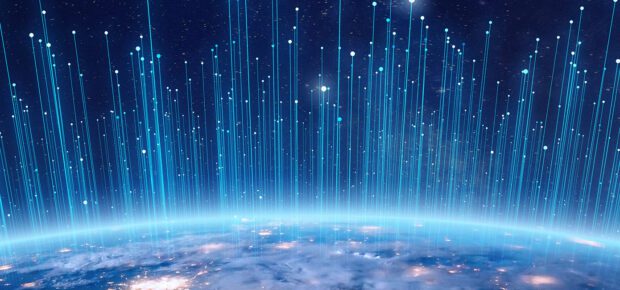January 25, 2023
The race for universal connectivity is heating up as everyone and their devices seek faster and more reliable communications.
But ubiquitous connectivity, and network computing using 5G and other technologies, create both challenges and opportunities for climate and sustainability efforts.
Overall, about 1.8 – 2.8% of global greenhouse gas emissions come from information and communication technology. The rise of 5G – with its ultra low latency and high data rates – will likely bring billions of more electricity-consuming devices online, not just for consumer use, but as sensors engaged in machine-to-machine communication and consuming more electricity, which in turn has potential to exacerbate climate change.
On a positive note, devices are increasingly power efficient. This power efficiency is enabled by semiconductor advances and cloud computing. Moore’s Law, which dictates that the computing power of semiconductors doubles every 18 months, allows us to create increasingly efficient devices using less energy.
Just two decades ago, most people were using personal computers that had energy-guzzling cooling fans and cathode-ray tube displays. Now we use mobile phones and wearables that last a day or more on battery power. Mobile devices offload some of their computing to data centers where engineers use liquid cooling and other techniques to increase energy efficiency.
A few years ago a home Wi-Fi network supported a half dozen devices. Today, they often have over five dozen connected devices, most of which are IoT “smart home” connected devices like light switches, smoke alarms, security sensors, smartwatches, etc.
Each of these consumes some power. Although it’s typically a very small amount per device, it can add up.
Ever-Increasing Efficiency Gains
One bright spot is the use of smart devices and sensors in home and industry to create more efficient systems. Smart devices can automatically turn lights off when a room is empty, or reduce demand for heating and cooling systems when buildings are unoccupied. The energy savings may easily outweigh the power consumption of the device or devices themselves.
And newer technologies like 5G and Wi-Fi 6e are inherently more efficient. A 4G network can transmit 300 high definition movies using the same amount of power with which a 5G network could transmit 5,000 movies.
Consider the latest trends: On average, each smartphone on the planet is expected to download approximately 19 GB of data per month. By 2028, that number is expected to more than double to 46 GB, possibly as high as 52 GB per month. And the act of transferring data – whether from a mobile device or a data center that hosts your favorite streaming service, uses electricity.
The big question is whether the efficiency gains – in the devices themselves and the use of those devices do drive energy efficiency in other processes – will outpace the impact from the number of devices coming online.
Choose and Use The Right Devices
So what can consumers do?
It’s important that people consider the quality of their devices, and buy accordingly. Lower-priced devices might be tempting due to up-front cost, but are they efficient? Pay attention to how much power a device uses. If it requires constant recharging, or always seems to need new batteries, you might want to consider other options.
Used properly, devices can actually help lower power consumption and reduce climate impacts. Comprehensive connectivity and network computing enable home and business management routines that create efficiencies. For example, a smart switch controlling an LED porch light that self-adjusts for local sunset and sunrise, or a household bedtime routine that ensures all lights turn off. A smart irrigation controller can self-adjust watering schedules based on live and predicted weather conditions. Presence sensors in offices can turn off lights and adjust heating/cooling in unused rooms. Voice assistants allow you to avoid using a phone, tablet, or PC to access information, saving power because screens require a large amount of energy to operate.
Time will tell how this plays out in the real world, and we’ll need to make adjustments to energy reduction strategies as technology continues to evolve. We’re still in the early days of ubiquitous connectivity and network computing, so I think this is an area where more study is needed, both on the engineering and policy aspects.
Learn More: Want an in-depth look at the role communication plays in climate change? This panel from the IEEE Future Directions has you covered.
ABOUT OUR AUTHOR IEEE Impact Creator David Witkowski is an IEEE Senior Member and Co-Chair of the Deployment Working Group at IEEE Future Networks, Founder & CEO of Oku Solutions LLC, Executive Director of the Civic Technologies Initiative at Joint Venture Silicon Valley, and a Fellow in the Radio Club of America.






 Liquid Infrastructure: Our Planet's Most Precious Resource
Liquid Infrastructure: Our Planet's Most Precious Resource The Impact of Technology in 2025
The Impact of Technology in 2025 Quantum and AI: Safeguards or Threats to Cybersecurity?
Quantum and AI: Safeguards or Threats to Cybersecurity? Why AI Can't Live Without Us
Why AI Can't Live Without Us Bits, Bytes, Buildings and Bridges: Digital-Driven Infrastructure
Bits, Bytes, Buildings and Bridges: Digital-Driven Infrastructure Impact of Technology in 2024
Impact of Technology in 2024 Emerging AI Cybersecurity Challenges and Solutions
Emerging AI Cybersecurity Challenges and Solutions The Skies are Unlimited
The Skies are Unlimited Smart Cities 2030: How Tech is Reshaping Urbanscapes
Smart Cities 2030: How Tech is Reshaping Urbanscapes Impact of Technology 2023
Impact of Technology 2023 Cybersecurity for Life-Changing Innovations
Cybersecurity for Life-Changing Innovations Smarter Wearables Healthier Life
Smarter Wearables Healthier Life Infrastructure In Motion
Infrastructure In Motion The Impact of Tech in 2022 and Beyond
The Impact of Tech in 2022 and Beyond Cybersecurity, Technology and Protecting Our World
Cybersecurity, Technology and Protecting Our World How Technology Helps us Understand Our Health and Wellness
How Technology Helps us Understand Our Health and Wellness The Resilience of Humanity
The Resilience of Humanity Harnessing and Sustaining our Natural Resources
Harnessing and Sustaining our Natural Resources Creating Healthy Spaces Through Technology
Creating Healthy Spaces Through Technology Exceptional Infrastructure Challenges, Technology and Humanity
Exceptional Infrastructure Challenges, Technology and Humanity The Global Impact of IEEE's 802 Standards
The Global Impact of IEEE's 802 Standards Scenes of our Cyber Lives: The Security Threats and Technology Solutions Protecting Us
Scenes of our Cyber Lives: The Security Threats and Technology Solutions Protecting Us How Millennial Parents are Embracing Health and Wellness Technologies for Their Generation Alpha Kids
How Millennial Parents are Embracing Health and Wellness Technologies for Their Generation Alpha Kids Space Exploration, Technology and Our Lives
Space Exploration, Technology and Our Lives Global Innovation and the Environment
Global Innovation and the Environment How Technology, Privacy and Security are Changing Each Other (And Us)
How Technology, Privacy and Security are Changing Each Other (And Us) Find us in booth 31506, LVCC South Hall 3 and experience the Technology Moon Walk
Find us in booth 31506, LVCC South Hall 3 and experience the Technology Moon Walk Virtual and Mixed Reality
Virtual and Mixed Reality How Robots are Improving our Health
How Robots are Improving our Health IEEE Experts and the Robots They are Teaching
IEEE Experts and the Robots They are Teaching See how millennial parents around the world see AI impacting the lives of their tech-infused offspring
See how millennial parents around the world see AI impacting the lives of their tech-infused offspring Take the journey from farm to table and learn how IoT will help us reach the rising demand for food production
Take the journey from farm to table and learn how IoT will help us reach the rising demand for food production Watch technical experts discuss the latest cyber threats
Watch technical experts discuss the latest cyber threats Explore how researchers, teachers, explorers, healthcare and medical professionals use immersive technologies
Explore how researchers, teachers, explorers, healthcare and medical professionals use immersive technologies Follow the timeline to see how Generation AI will be impacted by technology
Follow the timeline to see how Generation AI will be impacted by technology Learn how your IoT data can be used by experiencing a day in a connected life
Learn how your IoT data can be used by experiencing a day in a connected life Listen to technical experts discuss the biggest security threats today
Listen to technical experts discuss the biggest security threats today See how tech has influenced and evolved with the Games
See how tech has influenced and evolved with the Games Enter our virtual home to explore the IoT (Internet of Things) technologies
Enter our virtual home to explore the IoT (Internet of Things) technologies Explore an interactive map showcasing exciting innovations in robotics
Explore an interactive map showcasing exciting innovations in robotics Interactively explore A.I. in recent Hollywood movies
Interactively explore A.I. in recent Hollywood movies Get immersed in technologies that will improve patients' lives
Get immersed in technologies that will improve patients' lives